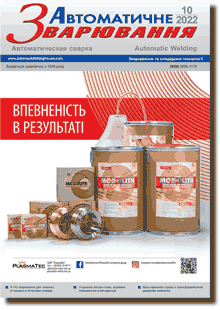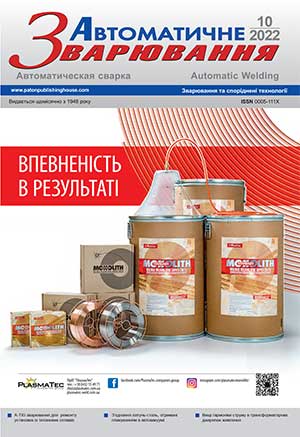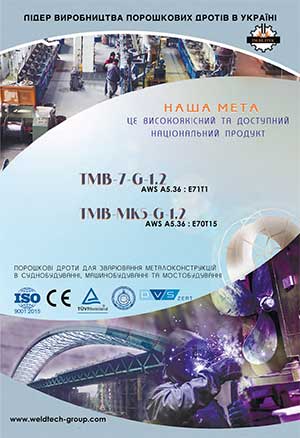| 2022 №10 (07) |
DOI of Article 10.37434/as2022.10.01 |
2022 №10 (02) |

"Avtomatychne Zvaryuvannya" (Automatic Welding), #10, 2022, pp. 7-16
Application of A-TIG welding for improving the technology of manufacturing and repair of units of gas turbine engines and installations from titanium alloys
D.V. Kovalenko, I.V. Kovalenko, B.O. Zaderii, G.V. Zvyagintseva
E.O. Paton Electric Welding Institute of the NAS of Ukraine. 11 Kazymyr Malevych Str., 03150, Kyiv, Ukraine. E-mail: office@paton.kiev.ua
The advantages of using the technology of A-TIG welding (TIG welding along the layer of activating flux – activator) of structurally complex elements of titanium alloys, including butt and spot overlapped joints of various thicknesses, as well as joints with variable heat dissipation, are shown. The relationship between the geometry of welds, structure and properties of welded joints produced by TIG and A-TIG welding methods was studied. A-TIG welding technology was tested in industrial conditions during creation and repair of problematic units of aircraft and convertible gas turbine engines. The A-TIG welding method is recommended for industrial implementation when creating welding structures from titanium alloys of a complex geometry. 15 Ref., 7 Tabl., 12 Fig.
Keywords: TIG and A-TIG welding, activators, titanium alloys, butt and spot overlapped joints, variable heat dissipation, weld formation, structure and properties
Received: 29.07.2022
References
1. Yushchenko, K.A., Kovalenko, D.V., Kovalenko, I.V. (2001) Application of activators for TIG welding of steels and alloys, 7, 37–43.2. Lucas, W., Howse, D. (1996) Activating flux – increase the performance and productivity of the TIG and plasma processes. Welding and Metal Fabrication, 1, 11–17.
3. Lucas, W. (2000) Activating Flux – Improving the performance of the TIG process. Welding and Metal Fabrication, 2, 7–10.
4. Dong, C., Katayama, S. (2004) Basic understanding of A-TIG welding process. IIW Doc.1802-04/Doc.212-1055-04
5. Paton, B.E., Yushchenko, K.A., Kovalenko, D.V. et al. (2006) Factors of increased penetrating capacity of A-TIG welding of stainless steel. IIW Doc.XII-1911-06, 17–29.
6. Yushchenko, K.A., Kovalenko, D.V., Krivtsun, I.V. et al. (2008) Experimental studies and mathematical modelling of metal penetration in TIG and A-TIG stationary arc welding. IIW Doc.212-1117-08.
7. Yushchenko, K.A., Kovalenko, I.V. Kovalenko, D.V. et al. (2000) A-TIG welding of nickel alloy NIMONIC-75. Svarshchik, 14(4), 26–27.
8.Gurevich, S.M., Zamkov, V.N., Blashchuk, V.E. et al. (1986) Metallurgy and technology of welding of titanium and its alloys. Kyiv, Naukova Dumka [in Russian].
9. Perry, N., Marya, S., Soutif, E. (1999) New perspectives of flux assisted GTA welding in titanium structures. Reactive Metals in Corrosive Applications Conference Proceedings, Jack Tosdale, Editor, Wah Chang, 55–62.
10. Paton, B.E., Zamkov, V.N., Prilutsky, V.P. et al. (2000) Contraction of the welding arc caused by the flux in tungstenelectrode argon-arc welding. The Paton Welding J., 1, 1–8.
11. Zamkov, V.N., Prilutsky, V.P. (2004) Theory and practice of TIG-F (A-TIG) welding (Review). The Paton Welding J., 9, 11-14.
12. Sun, Z., Pan, D. (2004) Welding of titanium alloys with activating flux. Science and Technology of Welding and Joining, 9, 4, 337-344. https://doi.org/10.1179/136217104225021571
13. Leconte, S., Pillard, P., Chaelle, P. et al. (2007) Effect of flux containing fluorides on TIG welding process. Ibid, 12, 2, 120-126. https://doi.org/10.1179/174329307X159810
14. Niagaj, J. (2012) Perculiarities of A-TIG welding of titanium and its alloys. Archives of metallurgy and materials, 57, 1, 39-44. https://doi.org/10.2478/v10172-011-0150-5
15. Prilutsky, V.P., Akhonin, S.V. (2014) TIG welding of titanium alloys using fluxes. Welding in the World, 58, 245-251. https://doi.org/10.1007/s40194-013-0096-5




